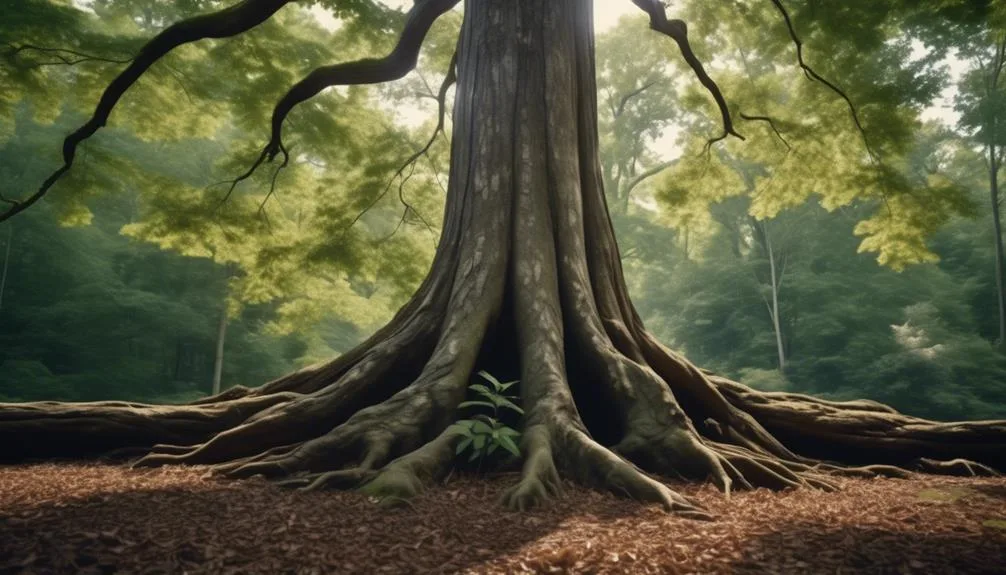Hickory trees have long fascinated us with their tall, wise appearance and enduring presence. Their exceptional longevity is attributed to genetic adaptations, slow growth, disease resistance, deep roots, and adaptability.
These factors work together to sustain the hickory trees through the ages. Understanding the secrets behind their enduring nature offers a glimpse into the remarkable traits that contribute to their long lifespan.
Genetic Adaptations
How do hickory trees' genetic adaptations contribute to their remarkable long lifespan?
Genetic diversity within hickory trees provides an evolutionary advantage that helps them thrive for centuries. Their ability to adapt to various environmental conditions, such as differing soil types and climate fluctuations, is due to their genetic diversity.
This diversity allows hickory trees to resist diseases, pests, and other stressors, contributing to their longevity. Additionally, their genetic adaptations help them efficiently extract nutrients from the soil, further enhancing their resilience.
Over time, these genetic adaptations have provided hickory trees with an evolutionary advantage, ensuring their survival and allowing them to flourish in diverse habitats. The intricate genetic makeup of hickory trees not only contributes to their impressive longevity but also highlights the significance of genetic diversity in maintaining healthy and robust tree populations.
Slow Growth Rate
The genetic adaptations that enable hickory trees to thrive for centuries also contribute to their slow growth rate, ensuring that each year's growth is deliberate and robust.
This slow growth rate is a result of the tree's efficient nutrient absorption, allowing it to make the most of available resources. Hickory trees have a remarkable ability to absorb essential nutrients from the soil, which supports their longevity but also leads to a slower growth process.
As a result, the tree rings, visible when a tree is cut, are tightly packed, indicating slow and steady growth. This deliberate growth pattern allows hickory trees to develop strong and durable wood, making them highly resilient to environmental stressors and ensuring their longevity in forests for generations to come.
Disease Resistance
Boasting exceptional resistance to diseases, hickory trees display a remarkable ability to fend off various pathogens and pests, ensuring their sustained health and longevity in forest ecosystems. Their natural defenses play a crucial role in disease prevention, contributing to their impressive lifespan.
Here's why hickory trees are so adept at warding off diseases:
- Chemical Compounds: Hickory trees produce natural compounds that act as deterrents to pests and pathogens, safeguarding their health and vitality.
- Thick Bark: The thick, rugged bark of hickory trees provides a protective barrier, reducing the risk of infections and infestations.
- Strong Immune System: These trees have a robust immune system that enables them to recognize and neutralize potential threats, promoting their overall resilience.
Deep Root Systems
With their disease-resistant qualities ensuring their sustained health and longevity, hickory trees also owe their vigor to their impressive deep root systems that play a crucial role in their survival within forest ecosystems.
The root structure of hickory trees consists of a taproot that grows deep into the soil, providing stability and access to water sources. Additionally, they develop a network of lateral roots that spread widely, enabling them to efficiently absorb water and essential nutrients from the soil.
This extensive root system allows hickory trees to withstand drought conditions by retaining water, which is essential for their long-term survival. Furthermore, the deep roots anchor the trees firmly, preventing soil erosion and ensuring their resilience against strong winds and other environmental stresses.
The remarkable water retention capacity of their roots contributes significantly to the enduring lifespan of hickory trees.
Environmental Adaptability
Adapting to various environmental conditions, hickory trees thrive in a range of habitats due to their remarkable resilience and flexibility.
Their climate resilience enables them to survive in diverse weather patterns, from the hot and humid climates of the southern regions to the cold and harsh winters of the north.
The survival strategies of hickory trees involve a deep understanding of their ecosystem interactions, allowing them to coexist with a wide variety of flora and fauna.
They contribute to habitat diversity by providing food and shelter for numerous species, further enhancing their adaptability.
Through these interactions, hickory trees have developed the ability to thrive in a multitude of environmental settings, making them a vital component of various ecosystems.
Conclusion
In observing the hickory tree's genetic adaptations, slow growth, disease resistance, deep roots, and environmental adaptability, we witness nature's enduring resilience and longevity.
The hickory stands as a testament to nature's remarkable evolution for survival.
What other marvels does the natural world hold, quietly waiting to be discovered?

My interest in trees started when I first saw the giant sequoias in Yosemite.
I was a teenager then, and I remember thinking, “I need to learn more about this.”
That moment stuck with me.
A few years later, I went on to study forestry at Michigan Tech.
Since graduating, I’ve worked in a mix of hands-on tree care and community education.
I’ve spent over ten years helping people understand how to plant, maintain, and protect the trees in their neighborhoods.
I don’t see trees as just part of the landscape.
They are living things that make a real difference in our daily lives.
